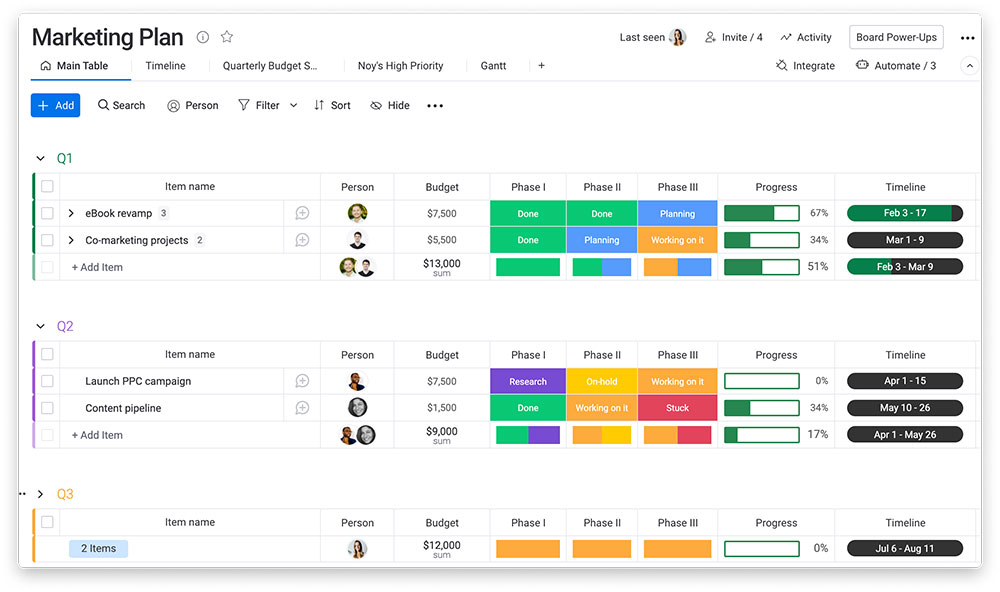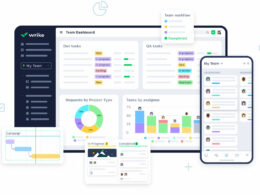Gap Analysis: What It Is And Why It’s Important

The secret to thriving in any competitive market lies in identifying and closing gaps. Imagine steering a ship without a map or compass; you’d be lost in uncharted waters. That’s precisely where gap analysis comes into play, bridging the chasm between current performance and desired goals.
In the bustling world of business, pinpointing performance gaps, assessing needs, and aligning strategic objectives are not just tasks—they’re lifelines.
Understanding the nuances of a gap analysis methodology helps in crafting robust improvement plans, optimizing resource allocation, and achieving strategic alignment.
By diving into this article, you’ll uncover the intricate steps of a gap analysis, exploring tools like SWOT analysis and performance review software. We’ll dissect key performance indicators (KPIs), benchmark data, and delve into efficiency gaps that could be holding you back.
Whether you’re looking to enhance skills, improve business processes, or boost overall performance, the insights here will guide you through the maze, ensuring your strategic goals are well within reach.
Table of contents
- When to Perform a Gap Analysis
- Steps of a Gap Analysis
- Tools and Models for Gap Analysis
- Examples of Gap Analysis
- Differences Between Gap Analysis and SWOT Analysis
- Common Mistakes in Gap Analysis
- Benefits of Using a Gap Analysis
- Gap Analysis Templates
What is gap analysis?
Gap analysis is a method to identify the differences between the current state and desired goals. By measuring performance metrics and evaluating resources, it helps pinpoint efficiency gaps and areas for improvement, guiding strategic planning and business improvement initiatives.
When to Perform a Gap Analysis
Strategic Planning
Aligning Business Goals
In the labyrinth of strategic planning, aligning business goals is paramount. It’s about setting clear objectives and ensuring they resonate with the company’s long-term vision.
A gap analysis helps in identifying where you stand versus where you want to be, providing a roadmap to navigate the corporate jungle.
Long-Term Vision
Crafting a long-term vision isn’t just about lofty ambitions. It requires a meticulous understanding of current capabilities and future aspirations.
This vision aligns with strategic objectives, ensuring every step taken is a stride towards sustained growth and success.
Performance Issues
Identifying Performance Gaps
Performance issues can be like shadows lurking in the corners of your organization.
A thorough gap analysis illuminates these dark spots, highlighting discrepancies between expected and actual performance.
This identification is the first step towards closing these gaps and enhancing overall efficiency.
Implementing Corrective Measures
Once performance gaps are identified, the next move is implementing corrective measures.
This involves not just addressing the symptoms but understanding the root causes. Corrective actions may range from additional training to process improvements, ensuring that performance aligns with strategic goals.
Stakeholder Context
Providing Insight to Stakeholders
Stakeholders crave insights. They need to understand the health of the business and the path to future success.
By performing a gap analysis, you provide them with a detailed view of the current state versus the desired state, fostering transparency and trust.
Enhancing Decision-Making
Decision-making is the lifeblood of any organization. Equipped with the insights from a gap analysis, stakeholders can make informed decisions.
These decisions are grounded in data and analysis, enhancing the strategic alignment and operational efficiency of the organization.
Steps of a Gap Analysis
Define Business Goals
Setting Clear Objectives
First, we need clarity. Objectives should be as sharp as a tack. What are we aiming for? Revenue targets? Market expansion?
These objectives form the cornerstone of our strategy. A gap analysis will compare these with current performance to spotlight the gaps.
Aligning Goals with Vision
Next, we align these goals with the company’s long-term vision. This isn’t just about ambition; it’s about feasibility.
The vision must sync with realistic milestones, ensuring that our strategic objectives are not just dreams but actionable steps toward success.
Benchmark Current Performance
Collecting Data
Data is king. We gather performance data through surveys, assessments, and historical records.
This involves a deep dive into key performance indicators (KPIs) and other relevant metrics, painting a picture of the current state of affairs.
Analyzing Current State
Analyzing this data reveals the lay of the land. We use tools like performance review software and benchmarking frameworks.
This analysis identifies strengths, weaknesses, and areas needing improvement, setting the stage for identifying gaps.
Analyze Gap Data
Identifying Discrepancies
Here’s where the magic happens. By juxtaposing the current state against our defined goals, discrepancies emerge.
These gaps are where opportunities for growth and improvement lie, signaling what needs to be fixed or enhanced.
Understanding Root Causes
It’s not enough to just see the gaps; we need to understand why they exist. Root cause analysis digs deeper, exploring underlying issues—be it competency gaps, resource limitations, or process inefficiencies. This step is crucial for devising effective corrective measures.
Compile a Detailed Report
Documenting Findings
Now, we compile everything into a comprehensive report.
This document should detail the gaps, their root causes, and potential impacts. Clear and precise, it serves as a blueprint for stakeholders, guiding future actions and decisions.
Presenting Actionable Insights
The final step is presenting these insights. This isn’t just about listing problems; it’s about offering solutions.
Actionable insights mean providing concrete recommendations for addressing the identified gaps, ensuring alignment with strategic objectives and enhancing overall performance.
Tools and Models for Gap Analysis
McKinsey 7S Model
Overview of the Model

Picture a spiderweb of interconnected elements. The McKinsey 7S Model spins around strategy, structure, systems, shared values, skills, style, and staff.
It’s a holistic framework, considering both the hard and soft elements of an organization.
Application in Gap Analysis
When wielding this model in a gap analysis, the goal is to dissect these elements. Are your systems aligned with your strategy? Does your staff have the necessary skills?
By analyzing each “S,” you uncover the performance gaps and areas ripe for improvement, paving the way for strategic alignment.
Nadler-Tushman Congruence Model
Overview of the Model

Think of the Nadler-Tushman Congruence Model as a jigsaw puzzle. It focuses on four critical components: work, people, structure, and culture.
The idea is to fit these pieces together to achieve high performance and operational efficiency.
Application in Gap Analysis
Applying this model means scrutinizing how well these components fit together. Are the tasks aligned with the structure?
Do the people have the competencies needed for the work? This analysis helps in identifying root causes of inefficiencies and crafting targeted improvement plans, ensuring each piece of the puzzle enhances the whole.
Using these models transforms the abstract concept of gap analysis into a structured, actionable process.
They guide us in evaluating performance metrics, understanding root causes, and implementing corrective measures to drive business improvement and strategic alignment.
Examples of Gap Analysis
Software Development
Identifying Feature Gaps
In the realm of software development, identifying feature gaps is crucial. Imagine you’re launching a new app, and there’s a chasm between user expectations and what your app delivers.
Conducting a gap analysis reveals these discrepancies, allowing you to enhance product development, meet market demands, and outperform competitors.
Improving Product Development
Improving product development means closing those gaps. Whether it’s adding new features, improving user experience, or fixing bugs, this process is essential.
You scrutinize every line of code, every user feedback, ensuring the final product is polished, functional, and ready to dominate the market.
Project Management
Analyzing Project Performance
Project performance can often deviate from initial plans. Analyzing these gaps helps identify inefficiencies and bottlenecks.
By comparing planned versus actual progress, you can pinpoint where things went off track, enabling you to implement corrective measures and keep the project aligned with its goals.
Enhancing Project Outcomes
Enhancing project outcomes involves more than just staying on schedule.
It’s about delivering quality results, meeting stakeholder expectations, and achieving project objectives.
Using gap analysis, project managers can refine processes, optimize resource allocation, and ensure successful project completion.
Human Resources
Identifying Skill Gaps
In HR, identifying skill gaps is like mapping uncharted territories. You assess employee competencies, compare them with job requirements, and uncover where the shortfalls lie.
This helps in crafting effective training and development plans, ensuring your workforce is equipped to meet organizational goals.
Training and Development Plans
Developing training plans is the next step. Tailored programs are designed to address the identified gaps, enhancing employee skills and performance.
This not only boosts individual capabilities but also strengthens the overall organizational efficiency, driving towards strategic objectives.
Competitive Research
Identifying Market Gaps

Competitive research is about understanding where your competitors stand and where the market opportunities lie.
Identifying market gaps means spotting unmet needs or underserved segments. This insight allows you to position your product strategically, capturing new market share and staying ahead of the competition.
Strategic Positioning
Strategic positioning is the art of standing out.
By leveraging the insights from your gap analysis, you can tailor your offerings to fill those market gaps, enhance your value proposition, and differentiate your brand.
This ensures you’re not just part of the market but leading it.
Differences Between Gap Analysis and SWOT Analysis
Definitions and Purposes
Gap Analysis: Internal Focus
Gap analysis zeroes in on the internal workings. It’s like an X-ray for your organization, highlighting performance gaps, competency issues, and areas where resources are lacking.
The purpose? To bridge the divide between current performance and strategic goals, ensuring alignment and operational efficiency.
SWOT Analysis: Internal and External Focus

SWOT analysis, on the other hand, casts a wider net. It evaluates strengths, weaknesses, opportunities, and threats, looking both inside and outside the organization.
This dual focus helps in strategic planning by balancing internal capabilities with external market conditions, providing a comprehensive view of where you stand.
Complementary Nature
How They Work Together
When these two analyses dance together, magic happens. Gap analysis pinpoints internal deficiencies, while SWOT analysis broadens the perspective to include external opportunities and threats.
Together, they offer a holistic approach to strategic planning, ensuring that you’re not just improving internally but also positioning yourself effectively in the market.
Benefits of Using Both
Combining these tools brings the best of both worlds. Gap analysis gives you detailed insights into internal improvement areas, while SWOT analysis helps you navigate the external landscape.
This synergy ensures that your strategies are well-rounded, addressing both internal weaknesses and external challenges, setting the stage for sustained growth and competitive advantage.
Common Mistakes in Gap Analysis
Overlooking Key Areas
Identifying Blind Spots
When conducting a gap analysis, it’s easy to miss the forest for the trees. Blind spots happen when critical areas are overlooked.
Maybe it’s an underperforming department or a subtle market shift. Missing these can skew your results and lead to misguided strategies. A comprehensive assessment means turning over every stone.
Comprehensive Assessment
A thorough approach is vital. Each facet of the organization, from resource allocation to competency gaps, needs scrutiny.
This prevents gaps in your analysis itself, ensuring no area is left unchecked. The broader and deeper the assessment, the more accurate the insights.
Inaccurate Data Collection
Ensuring Data Accuracy
Data is the lifeblood of gap analysis. But garbage in, garbage out. Inaccurate or incomplete data can lead to false conclusions.
It’s crucial to ensure the data collected is accurate, up-to-date, and relevant. This includes performance metrics, employee feedback, and market data.
Reliable Data Sources
Depend on reliable data sources. Use verified internal reports, reputable industry benchmarks, and precise performance review software.
Cross-checking data from multiple sources helps in validating its accuracy, providing a solid foundation for your analysis.
This meticulous approach safeguards against errors and misguidance.
Benefits of Using a Gap Analysis

Enhanced Strategic Planning
Improved Goal Alignment
Think of your business goals as stars in the sky. Without a map, you’d be lost trying to reach them.
Gap analysis serves as that map, aligning your strategic objectives with reality.
It ensures every step taken is in sync with your long-term vision, minimizing detours and missteps.
Clearer Roadmaps
The road to success can be winding and treacherous. With gap analysis, you chart a clearer course.
Detailed insights from performance metrics and benchmarking tools illuminate the path, helping you avoid obstacles and stay focused on the destination.
Better Performance Management
Identifying Improvement Areas
Performance management is like tuning a high-performance engine. Gap analysis identifies the misfires.
By pinpointing areas needing improvement—be it in process efficiency, resource allocation, or competency gaps—you ensure the engine runs smoothly, propelling the organization forward.
Implementing Effective Solutions
It’s not just about spotting issues; it’s about fixing them. Gap analysis provides actionable insights, guiding the implementation of effective solutions.
Whether it’s additional training, process optimization, or strategic realignment, these measures ensure performance enhancements and operational efficiency.
Gap Analysis Templates
Gap Analysis Template from Miro
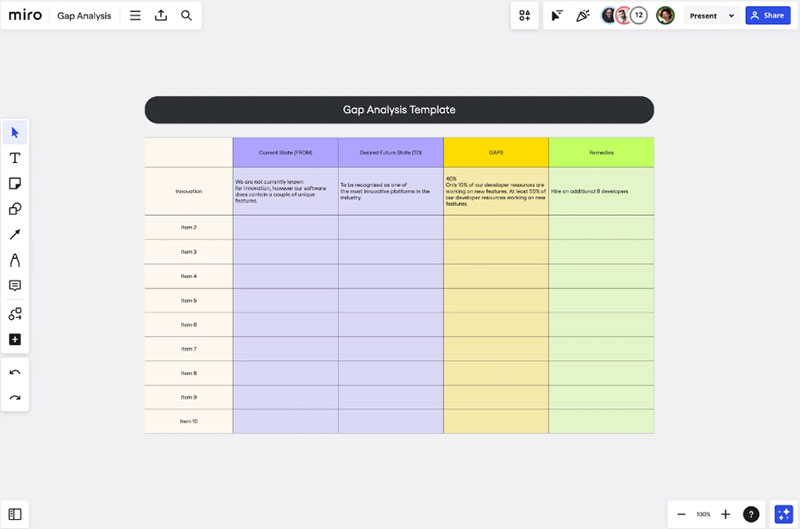
Excel Gap Analysis Template
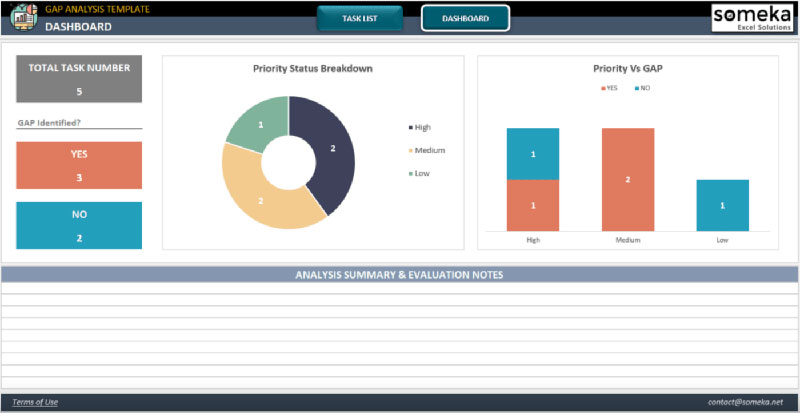
Marketing Gap Analysis Template
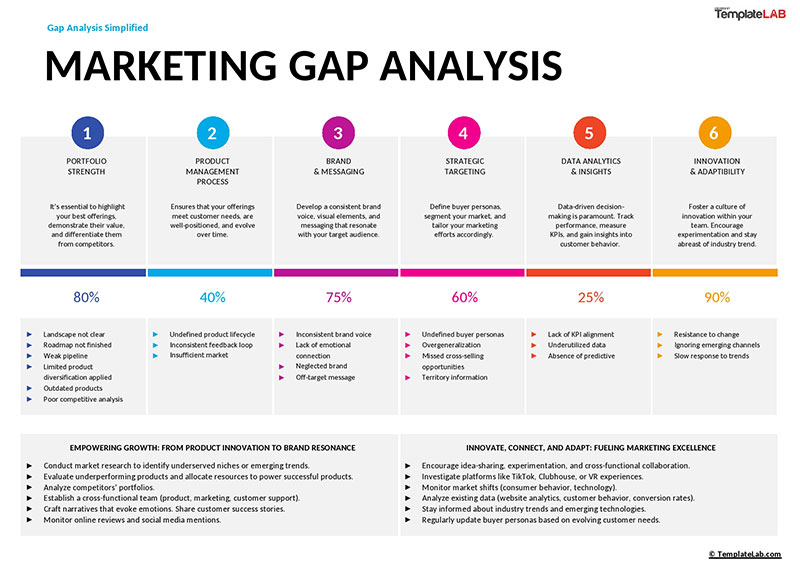
Gap Analysis Template from ProjectManager.com
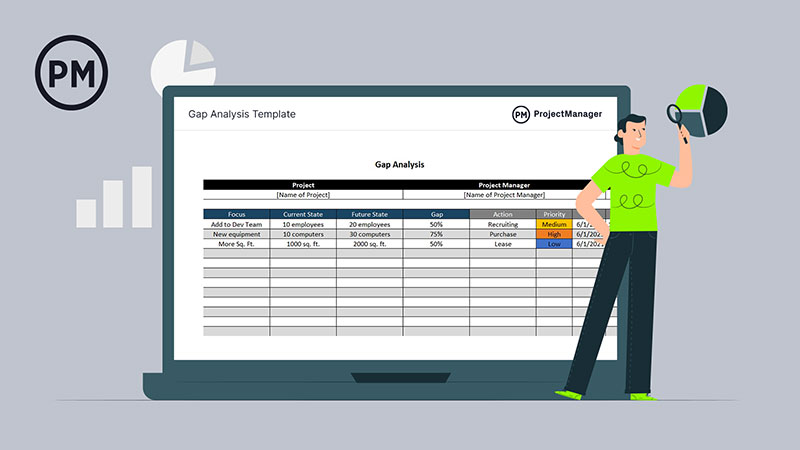
FAQ on Gap Analysis
Why is gap analysis important?
It’s crucial for aligning strategic objectives with actual performance. By identifying competency gaps and areas needing improvement, organizations can optimize resource allocation, enhance productivity, and achieve business goals more effectively, ensuring competitive advantage and continuous growth.
How do you perform a gap analysis?
Start with a needs assessment to understand current performance. Then, define desired outcomes and use tools like SWOT analysis and performance review software. Identify gaps by comparing current state with goals. Finally, develop an improvement plan and monitor progress using key performance indicators (KPIs).
What tools are used in gap analysis?
Common tools include SWOT analysis, benchmarking tools, performance review software, and various assessment frameworks. These help in gathering data, measuring performance metrics, and analyzing discrepancies between current and desired states, facilitating effective strategic planning and process improvement.
What are the types of gap analysis?
There are several types: performance gap, skills gap, market gap, and process gap. Each focuses on different aspects like employee competencies, market opportunities, operational efficiencies, and overall organizational performance, helping businesses address specific areas needing improvement.
How can gap analysis improve business performance?
By identifying and addressing performance gaps, it helps in optimizing processes, improving productivity, and achieving strategic alignment. This leads to better resource allocation, enhanced efficiency, and meeting business goals more effectively, ultimately driving business improvement and competitive advantage.
What are the common challenges in gap analysis?
Challenges include accurately assessing the current state, setting realistic goals, and gathering reliable data. Additionally, resistance to change, inadequate resources, and lack of clear communication can hinder the implementation of improvement plans derived from gap analysis.
How often should a gap analysis be performed?
It should be conducted regularly, often aligned with strategic planning cycles, performance reviews, or when significant changes occur in the market or within the organization. Regular assessments help in continuously improving processes and maintaining alignment with business goals.
What industries benefit most from gap analysis?
All industries can benefit, but it’s particularly crucial in sectors like healthcare, education, manufacturing, and IT. These industries face constant changes and need regular assessments to improve efficiency, meet regulatory requirements, and stay competitive in their respective markets.
How does gap analysis relate to strategic planning?
Gap analysis is integral to strategic planning as it identifies the gaps between current performance and strategic objectives. By understanding these gaps, organizations can develop targeted improvement plans, align resources effectively, and ensure their strategic goals are met efficiently.
Conclusion
The journey through gap analysis unveils the path to bridging the divide between current performance and strategic goals. By dissecting performance metrics and leveraging tools like SWOT analysis and benchmarking, we pinpoint efficiency gaps and competency needs. This method not only enhances business improvement but also optimizes resource allocation and ensures strategic alignment.
Incorporating key performance indicators (KPIs) and performance review software, gap analysis provides a robust framework for continuous improvement. It’s not just about identifying gaps—it’s about crafting actionable plans that drive productivity and competitive advantage.
Through needs assessments and a thorough understanding of strategic objectives, businesses can navigate the complexities of operational audits and market analysis. This holistic approach ensures that no stone is left unturned, leading to a comprehensive understanding of where the organization stands and where it needs to go.
Ultimately, mastering gap analysis is essential for any organization striving for excellence and sustained growth.
If you enjoyed reading this article on gap analysis, you should check out this one about project management framework.
We also wrote about a few related subjects like Kanban apps, what is a war room, project management books, project management principles, project management goals, project management metrics, IT project manager, project management skills, and project management methodologies.
- Gap Analysis: What It Is And Why It’s Important - May 14, 2024
- What Is a War Room and How to Use it in Project Management - April 23, 2024
- Business model innovation: What it is and why it matters - April 20, 2024





